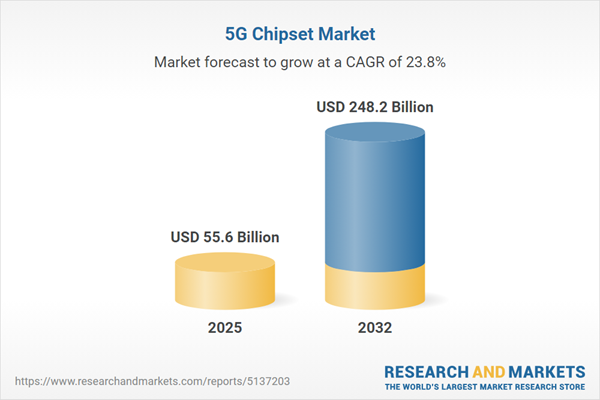Speak directly to the analyst to clarify any post sales queries you may have.
The 5G chipset market is at a crucial inflection point for industries seeking robust, scalable connectivity solutions. Businesses navigating this landscape require precise, actionable intelligence to inform technology strategies and investment priorities.
Market Snapshot: 5G Chipset Market Growth Trajectory
In recent years, the 5G chipset market has shown significant expansion, advancing from USD 44.88 billion in 2024 to USD 55.60 billion in 2025, supported by a compound annual growth rate (CAGR) of 23.83%. Industry projections signal a substantial increase in market value, reaching USD 248.20 billion by 2032. The progression from pilot projects to commercial deployments is propelled by advances in process nodes, robust RF integration, and a focus on application-centric architectures. As these technologies mature, enterprises gain access to faster, more reliable, and higher-capacity wireless solutions, unlocking new growth avenues across sectors.
Scope & Segmentation Across the 5G Chipset Ecosystem
- End Use: Automotive—including Advanced Driver Assistance Systems, infotainment, and telematics; enterprise industrial solutions enabling automation and operational efficiency; Internet of Things devices spanning consumer and industrial use cases; and smartphones, driving mass-market connectivity.
- Technology: Segmentation by non standalone and standalone network architectures reflects the industry’s evolution from legacy enhancements to fully virtualized, independent deployments.
- Frequency: Spectrum coverage includes MmWave (26 GHz, 28 GHz, 39 GHz) for ultra-high-speed applications and Sub 6 GHz (2.5 GHz, 3.5 GHz, 600 MHz) for broad regional penetration and reliability.
- Component: Baseband processors, RF front end modules (encompassing filters, power amplifiers, switches), and system on chip solutions comprise the foundational hardware supporting connectivity and performance optimization.
- Process Node: Advancements range from fourteen nanometers down to three nanometers, enabling greater integration, power efficiency, and support for advanced use cases like edge computing.
- Application: Key applications are fixed wireless access for last-mile connectivity, IoT connectivity—covering enhanced mobile broadband, massive machine type communication, and ultra-reliable low latency use cases—and mobile broadband, pivotal for end-user experiences.
- Data Rate: Enhanced mobile broadband, massive machine type communication, and ultra-reliable low latency communication each address specific industry demands and user contexts.
- Regions: Coverage spans the Americas (including North America and Latin America), EMEA (comprising European, Middle Eastern, and African markets), and Asia-Pacific, each characterized by distinct demand drivers and infrastructure investment patterns.
- Company Profiles: The ecosystem features major players such as Qualcomm Incorporated, MediaTek Inc., Samsung Electronics Co., Ltd., Apple Inc., UNISOC Communications Inc., Huawei Technologies Co., Ltd., Intel Corporation, NXP Semiconductors N.V., Marvell Technology Group Ltd., and Broadcom Inc., each contributing vital technology and market leadership.
Key Takeaways for Senior Decision-Makers
- Segment-specific innovation—especially in automotive, enterprise, and IoT sectors—is accelerating deployment, enabling enhanced mobility and performance-driven solutions for industry leaders.
- The industry’s transition from initial network architectures toward standalone solutions is unlocking advanced features, providing enterprises with new capabilities for private network implementations and customized connectivity.
- Ongoing miniaturization through advanced process nodes strengthens energy efficiency, improves integration of edge artificial intelligence, and supports demanding throughput requirements in evolving digital environments.
- Collaboration among chipset manufacturers, network operators, and standardization bodies is critical to ensure interoperability and efficient, end-to-end deployment.
- Device manufacturers and chipset providers are strategically aligning supply chains and pricing models to address regulatory shifts and market volatility, leveraging flexible sourcing and robust inventory management.
- Regional differences in infrastructure investment—particularly rapid adoption in Asia-Pacific and strategic expansions in the Americas and EMEA—are shaping divergent deployment strategies and technology priorities worldwide.
Tariff Impact on the 5G Chipset Supply Chain
Recent tariff measures introduced by the United States in 2025 have significantly altered procurement strategies and cost models for global 5G chipset supply. Companies have responded by diversifying foundry sourcing and expanding alternative production sites to strengthen operational resilience. Forward-looking supply agreements, active inventory controls, and negotiation with original equipment manufacturers are becoming best practices. These adjustments help minimize cost volatility and maintain a competitive edge, safeguarding continuity and responsiveness across global markets.
Methodology & Data Sources
This assessment is grounded in primary interviews with senior industry executives, comprehensive secondary research, scenario analysis, and expert peer review. Data triangulation ensures reliable, actionable market insights that reflect current and emerging trends in technology development and market adoption.
Why This Report Matters
- Supplies unbiased, decision-ready intelligence on evolving 5G chipset market dynamics for strategic planning and technology development.
- Equips executives with a holistic view of opportunities, risks, and key alliances from regional and segment standpoints.
- Informs resource allocation through detailed segmentation analysis, market trend identification, and competitive landscape mapping.
Conclusion
This report positions senior decision-makers to navigate the dynamic 5G chipset environment through innovative strategies and resilient ecosystem partnerships. Focused attention on technology trends, supply chain agility, and regional differences will underpin sustainable leadership in this market.
Additional Product Information:
- Purchase of this report includes 1 year online access with quarterly updates.
- This report can be updated on request. Please contact our Customer Experience team using the Ask a Question widget on our website.
Table of Contents
3. Executive Summary
4. Market Overview
7. Cumulative Impact of Artificial Intelligence 2025
List of Figures
Companies Mentioned
The key companies profiled in this 5G Chipset market report include:- Qualcomm Incorporated
- MediaTek Inc.
- Samsung Electronics Co., Ltd.
- Apple Inc.
- UNISOC Communications Inc.
- Huawei Technologies Co., Ltd.
- Intel Corporation
- NXP Semiconductors N.V.
- Marvell Technology Group Ltd.
- Broadcom Inc.
Table Information
| Report Attribute | Details |
|---|---|
| No. of Pages | 194 |
| Published | October 2025 |
| Forecast Period | 2025 - 2032 |
| Estimated Market Value ( USD | $ 55.6 Billion |
| Forecasted Market Value ( USD | $ 248.2 Billion |
| Compound Annual Growth Rate | 23.8% |
| Regions Covered | Global |
| No. of Companies Mentioned | 11 |








